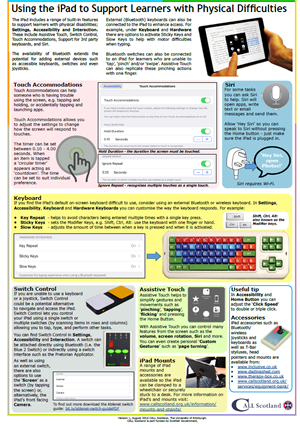 Newsletter: join thousands of other people
Newsletter: join thousands of other people
Once a month we'll send you an email with news, research and thoughts, as well as training courses and free webinars you may wish to attend.
Our websites:
Posted by Craig Mill on the 19th August, 2016

To make the most of a touch screen tablet device, such as an iPad, requires a user to make a range of ‘multi-touch’ gestures such as touching, tapping, swiping, pinching, rotating, zooming in and out, clicking, double clicking and even triple clicking.
 For someone with a physical difficulty such as fine motor skills or limited movement in their hands and fingers, the iPad may not appear to be the ideal choice.
For someone with a physical difficulty such as fine motor skills or limited movement in their hands and fingers, the iPad may not appear to be the ideal choice.
Fortunately, the iPad includes a range of built-in features to support people with a physical disability.
In Settings, Accessibility and under the Interaction category there are tools, such as Assistive Touch and Touch Accommodations which allows you to adjust the way the screen responds to different gestures, such as touching and tapping. AssistiveTouch for example, has a facility to replicate pinching and rotating gestures (which normally requires two hands/fingers) using only one finger.
Siri can also be used to carry out various tasks, for example, you can ask Siri to open Apps, write text messages or emails and send them without touching the iPad.
Additionally, because the iPad (and other tablet devices) has Bluetooth it is possible to connect numerous accessories, such as large or small external keyboards, switches, and joysticks. Wheelchair mounts, T-Bar styluses, and head pointers also offer alternative access to the iPad.
CALL Scotland is therefore pleased to announce the release of a new resource; 'Using the iPad to Support Learners with Physical Difficulties’ – an easy-to-use guide. This new guide adds to the CALL series of posters/guides; ‘Using the iPad to Support’ Dyslexia, Visual Difficulties and Creativity.
The new resource is primarily aimed at Teachers and Support for Learning Teachers, particularly those supporting pupils with a physical difficulty.
Please note the guide is designed to be printed in A3 size.
Another valuable resource is Touch Tap Swipe produced by DMD Pathfinders which offers information on choosing and using touch phones and tablets for people with minimal body movement.

4-week short study online course

Once a month we'll send you an email with news, research and thoughts, as well as training courses and free webinars you may wish to attend.
Our social media sites - YouTube, Twitter and Facebook